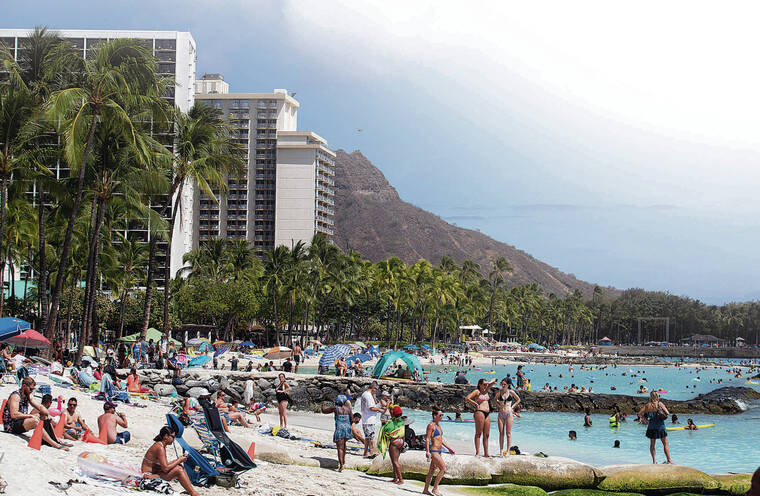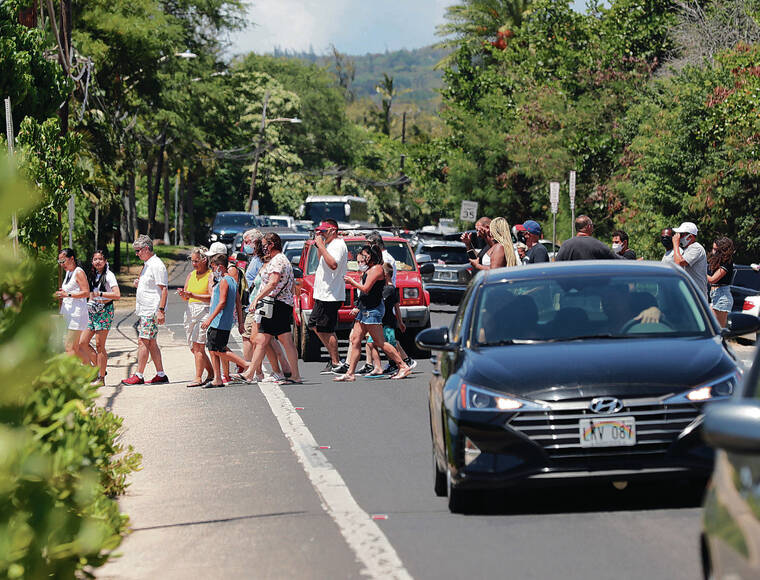Hawaii’s overtourism may get worse than ever

CINDY ELLEN RUSSELL / CRUSSELL@STARADVERTISER.COM
Beachgoers gather on the shores of Waikiki in 2021.

JAMM AQUINO / JAQUINO@STARADVERTISER.COM
A tour group crosses Kamehameha Highway toward Turtle Beach in Laniakea in 2021.


In early 2021, Hawaii’s tourism board kicked off a trailblazing plan to inject authentic Native Hawaiian culture into every facet of its visitor industry, using it to help protect its communities and fragile places while deepening the tourist experience. Now, just three years in, the “Malama Hawaii” or “Care for Hawaii” initiative to push sustainable tourism may be on its way out.
As a busy summer travel season impends, Hawaii’s legislators have allocated no funds for the state’s 25-year-old tourism office in the proposed state tourism budget bill for fiscal year 2023-2024, which will kick off on July 1. And late in April, lawmakers considered two bills to disband the Hawaii Tourism Authority and replace it with an agency that would focus less on marketing Hawaii to tourists and more on managing the destination’s resources.
The bill was deferred and HTA remains in place, but numerous knowledgeable people who spoke to Bloomberg predict that excluding the agency in the final budget would significantly curtail HTA’s efforts in managing tourism on the islands.
John De Fries, chief executive officer at the Hawaii Tourism Authority, said in a newsletter that without funding, the HTA’s work in destination management, visitor education and brand marketing work will be jeopardized. The HTA, he said, will be “making tough decisions in the coming days” about canceling existing contracts and “ongoing community work.”
Legislators said the tourism office can tap into $30 million in unused funds from the American Rescue Plan Act to continue managing tourism — equal to half the money that the HTA had requested for the upcoming fiscal year.
All this poses an existential threat to the cultural activities, festivals and community-led volunteer opportunities that have recently made Hawaii such a vibrant place to visit — as well as improved crowd control measures protecting the state’s most fragile places.
Don't miss out on what's happening!
Stay in touch with breaking news, as it happens, conveniently in your email inbox. It's FREE!
Tourism tensions
The friction between legislators and Hawaii’s tourism office is not new. It reached a boiling point in 2019, when Hawaii’s 1.5 million residents watched it become a case study in over- tourism amid 10.4 million annual arrivals. Among the side effects of that unregulated industry: garbage littering popular sights, beaches so crowded you’d have a hard time finding space for a towel, coral reefs suffering from bleaching, traffic snarls caused by selfie-snapping tourists, and sacred places being desecrated by graffiti and spray paint.
For many Hawaiians inside and outside the government, HTA was a victim of its own success marketing the state. And for that, HTA began giving itself a major overhaul.
A leadership of largely white executives was replaced with one almost entirely comprising Native Hawaiians; the agency’s goals were refocused on making tourism more sustainable for everyone.
The “Malama Hawaii” campaign took off. It spread responsible tourism messaging to visitors before and during their trips and created sustainable experiences to help visitors be more mindful of the fragility of Hawaii’s beautiful and sacred places. It also helped disperse foot traffic to reduce the harmful impacts of mass tourism.
The changes helped attract more affluent, higher- spending travelers, which explains why in 2023 the state is projected to bring in a record $1 billion in hotel bed taxes. Those guests, in turn, were happy to contribute to educational community-led activities such as beach cleanups in Kauai, tours of a chocolate farm on Oahu and joining cultural walks in Waikiki.
For some Hawaiian legislators that progress was too slow. The government has since reined in the tourism office’s spending powers, cut off its direct line of funding from hotel taxes and began requiring state approval to award contracts and pass annual budgets.
“The Legislature didn’t think (the change) was going fast enough,” says Frank Haas, president of Marketing Management Inc. and a consultant for the HTA’s 2020-25 strategic plan for sustainable tourism development.
Mondy Jamshidi-Kent, a professor of travel management at the University of Hawaii at Manoa, says some legislators have been committed for at least five years to disbanding the HTA, having made up their minds before De Fries could get to work.
“I’m disappointed to have learned that they don’t incorporate the last three years of statistically measured improvement,” she says, arguing that the current discussions are driven more by emotion than data. ”This is a disturbing threat to our democratic process.”
Jamshidi-Kent speculates that this “new way of tourism,” which centers Hawaiian culture in business operations and adds layers of true accountability, may have been perceived as threatening by certain members of the government. “It doesn’t make sense why the Legislature is trying to fix something that’s working.”
Seeds of sustainability
In a short period, HTA had made measurable progress. More than 25% of mainland visitors to Hawaii surveyed during the fourth quarter of 2022 reported seeing messaging before and during their trip about “caring for and respecting Hawaii’s culture, people, and environment.”
On the sustainability front, a growing number of state parks now require reservations; the 4,000-acre ‘Iao Valley State Monument on Maui just became the fourth state park using an advance booking system for out-of-state visitors, as of May 1. The number of community- run volunteer experiences for tourists via HTA-funded pilot programs led by the Native Hawaiian Hospitality Association, in collaboration with nonprofit organization Travel2change, more than doubled, from 30 to about 70, in recent years.
All this helped improve sentiment among residents about tourism, explains Malia Sanders, executive director of NaHAA. A quarterly survey taken in the fall showed that almost half of 1,949 Hawaii residents surveyed statewide said they believed tourism was being better managed than previously; there was little change, however, in the number saying their own island is being run for tourists at the expense of residents.
What comes next
Those calling for the closure of HTA favor building a different kind of tourism office that would focus exclusively on sustainable management of tourism, not marketing to tourists. It would take time to establish, and it will come with costs.
At risk are programs and experiences that are as valuable to travelers as to locals: HTA-sponsored events like the Hawaii Book and Music Festival on Oahu, which celebrates Hawaiian heritage and cultures through storytelling and song; the Hawaii Food & Wine Festival; the Maui Ukulele Festival; and the Big Island Chocolate Festival. These festivals help put Hawaiian artists and culture in the spotlight, giving visitors a richer experience and locals meaningful revenue streams.
Unless Gov. Josh Green vetoes the proposed state budget, many of these programs would probably suffer cuts in the next three to six months.
“To take all that away is terrifying,” says Sanders of the Native Hawaiian Hospitality Association. Also at risk would be the reservations systems and crowd control measures that are currently mitigating over- tourism in Hawaii’s most fragile and beautiful corners.
One solution would involve rethinking the HTA’s place in the government, giving it authority to work collaboratively with such other agencies as the Department of Land and Natural Resources, says tourism marketing veteran Haas. Goodwill to support such a radical restructuring may be lacking.
Outreach should be a part of any future agency’s mission, argues Sanders. Without it, she asks, “How do we attract the right kind of visitor that is willing to be educated while they are here — willing to contribute and be a part of social change?”
Jamshidi-Kent agrees. Marketing, she explains, makes the difference between telling visitors, “Hey, come to Hawaii, lay on the beach, have a mai tai,” to saying, “Hey, we would love you to come, but remember this is our home. You have to take care of this place.”



